





CBW84.jpg (taken 24.10.2014)
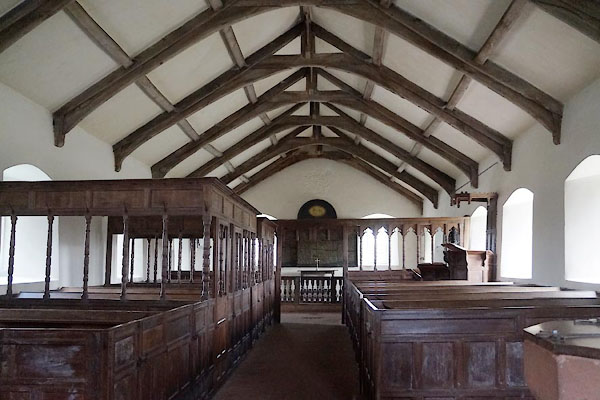
CBW87.jpg (taken 24.10.2014)
placename:- St Ninian's Church
"St Ninian's Church (Rectory)"
placename:- Nynechurches

Sax9NY53.jpg
Church, symbol for a parish or village, with a parish church. "Nynechurches"
item:- private collection : 2
Image © see bottom of page
placename:- Nynechurches
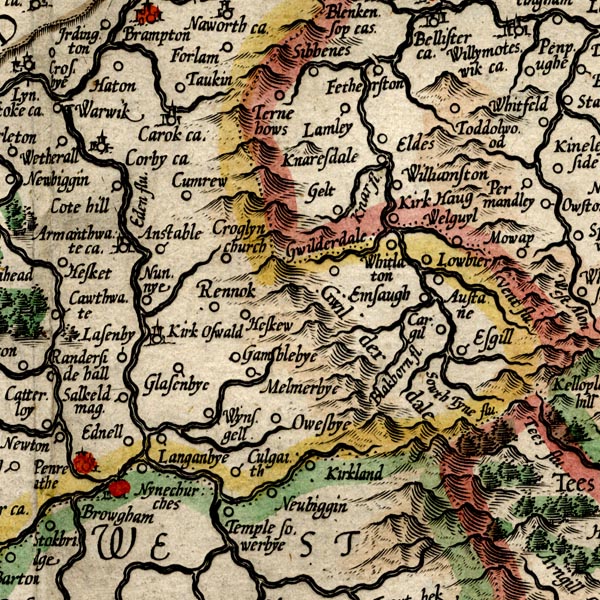
MER8CumD.jpg
"nynechurches"
circle
item:- JandMN : 169
Image © see bottom of page
placename:- Ninechurches

SP11NY53.jpg
"Ninechurches"
circle, building, tower; Westmorland
item:- private collection : 16
Image © see bottom of page
placename:- Ninechurches
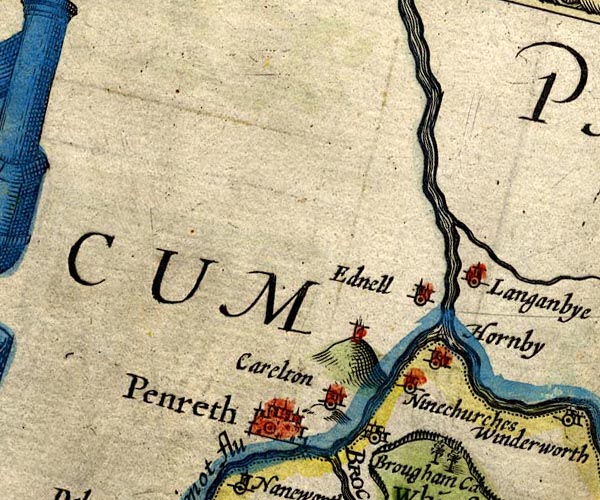
SP14NY53.jpg
"Ninechurches"
circle, tower
item:- Armitt Library : 2008.14.5
Image © see bottom of page
placename:- Ninechurches
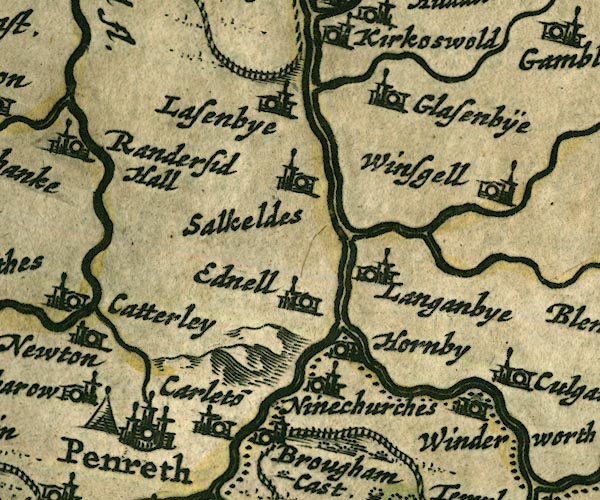
JAN3NY53.jpg
"Ninechurches"
Building and tower.
item:- JandMN : 88
Image © see bottom of page
placename:- Ninechurches
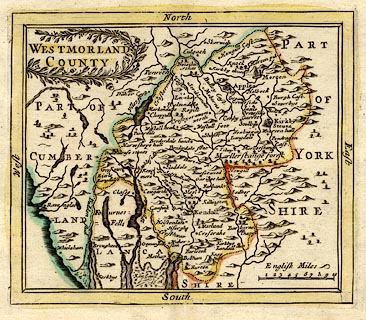 click to enlarge
click to enlargeSEL7.jpg
"Ninechurches"
circle, italic lowercase text; settlement or house
item:- Dove Cottage : 2007.38.87
Image © see bottom of page
placename:- Ninechurch
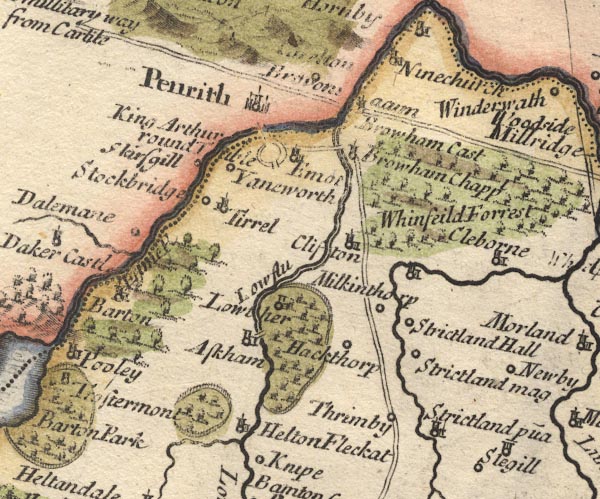
MD10NY52.jpg
"Ninechurch"
Circle, building and tower.
item:- JandMN : 24
Image © see bottom of page
placename:- Browham Chapel
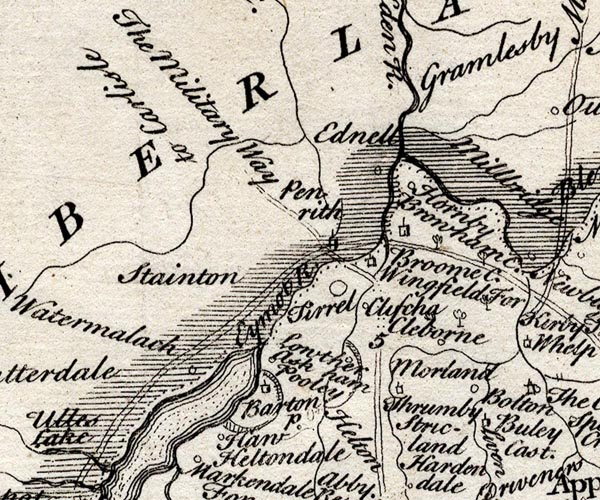
SMP2NYL.jpg
"Browham C."
item:- Dove Cottage : 2007.38.59
Image © see bottom of page

BO18NY42.jpg
circle, tower
item:- Armitt Library : 2008.14.10
Image © see bottom of page
placename:- Nine Churches
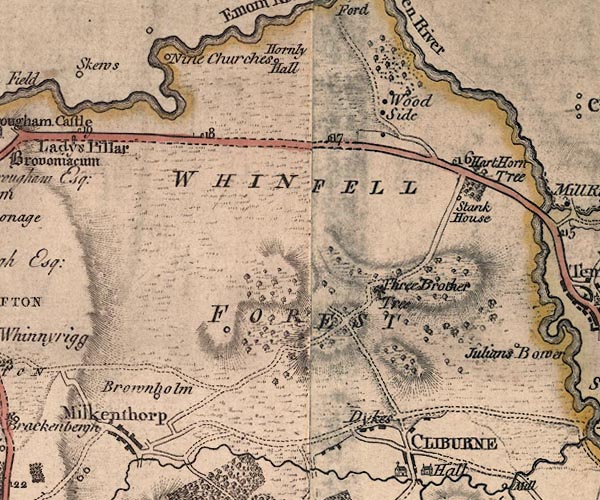
J5NY52NE.jpg
"Nine Churches"
circle, labelled in italic lowercase text; settlement, farm, house, or hamlet?
item:- National Library of Scotland : EME.s.47
Image © National Library of Scotland
placename:- Nine Churches
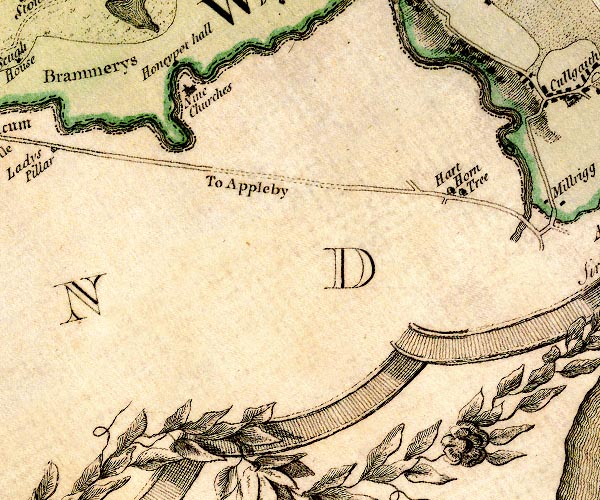
D4NY52NE.jpg
"Nine Churches"
church
item:- Carlisle Library : Map 2
Image © Carlisle Library
placename:- St Ninians
placename:- Nine Churches
 goto source
goto sourcePage 162:- "..."
"... in a peninsula is St. Ninians, vulgarly called Nine churches, the parish church of Brougham. The late rector of this and Clifton, Mr. Patten, was a correspondent of Dr. Stukeley and Mr. Gale, and gave them a particular account of the many antiquities in this neighbourhood. His daughter Mrs. Bockham, who 1771 kept a farm near Arthur's round table, told me, that, on her removal from Newcastle she burnt a great collection of these letters and drawings of seals, &c."
placename:- Nine Churches
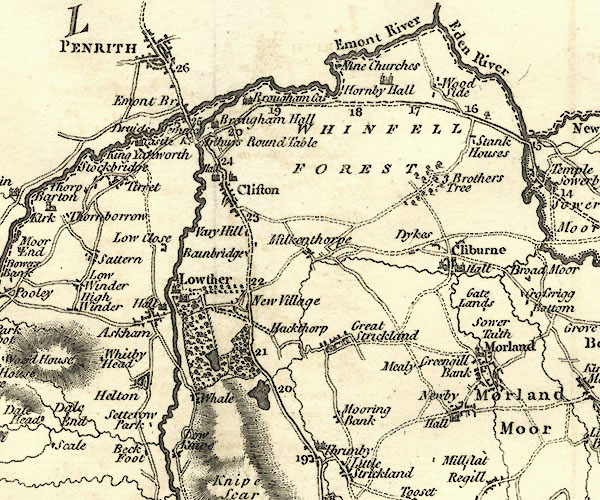
CY24NY52.jpg
"Nine Churches"
block/s, labelled in italic lowercase; house, or hamlet
item:- JandMN : 129
Image © see bottom of page
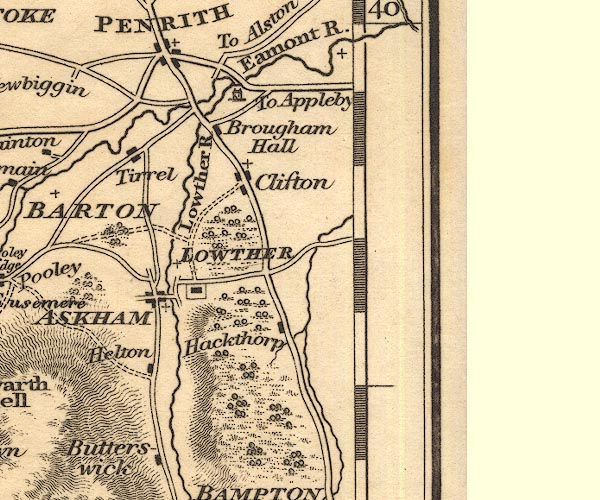
OT02NY52.jpg
Marked by a cross.
item:- JandMN : 48.1
Image © see bottom of page
item:- knight templar; Crusades
 goto source
goto sourceGentleman's Magazine 1846 part 2 pp.632-633
page 632:- "Mr. W. Brougham gave an account of the discovery of the supposed remains of a knight-templar, during the late repairs of Brougham church, Westmoreland. The sword (of which a drawing was shown) was in a perfect state; but Mr. Brougham stated that only one spur had been found; a circumstance which may possibly be attributed to the difficulty of adjusting the legs, which were, as usual, crossed, to the dimensions of the wooden coffin in which the body had been originally inclosed. It was remarkable that a fragment of glass of undoubted Phoenician fabric was found with these remains. The general opinion seemed to be, that it had been worn by the deceased as a talisman; and it, in some degree, corrobo-"
page 633:- "[corrobo]rated a tradition which, according to Mr. Brougham, had always associated the interment in question with an ancestor of the family, said to have joined one of the Crusades during the twelfth century"
placename:- Nine Kirks
 goto source
goto sourceGentleman's Magazine 1848 part 1 p.373 "..."
"The [Brougham] family burial aisle is not in the chapel at the hall, but in the chancel of Brougham church, or as sometimes called "Nine Kirks;" and here from"
 goto source
goto sourceGentleman's Magazine 1848 part 1 p.374 "the Saxon times have the family constantly deposited their dead. A quiter and more peacable resting place could not well be imagined. It is between three and four miles from the hall, lying apart from any habitation in a sequestered nook of land occupying the bend of the river, and altogether is one of thoses little quaint old-world spots consecrated by religion which are more frequently mentioned in books than to be found in reality."
"The church itself is a very similar structure to the chapel at Brougham, but not near in so good repair, and has a musty, mouldy smell of decay so usual in such out-of-the-way churches. Beside the chancel door lie three stone coffin-lids, seemingly kicked out of the chancel to make room for some subsequent memorials, since become also antiquated, and till of late years but little either noticed or cared for. The church has an open timbered oaken roof, arches with wind braces, &c. and, in spite of repairs circa 1660, which have destroyed and nearly obliterated the original architecture, it has a solemn gloom, from the smallness of its round-headed windows, filled with dim old dingy and smudged green glass. The principal object of attraction is the disinterment made in the year 1846, and so well described in the Archaeological Journal by Mr. Brougham, with attendant notes by Mr. Albert Way. Oaken trap-doors have been contrived, in the most judicious manner, which lift up with rings, and now disclose the remains, as discovered, but minus the relics of the spur, metallic end of horn, and sword, now at the hall. The first skeleton discovered was cross-legged, and with the spur in question upon the left-heel, but with none on the right, or any trace of there having been any. This curious fact, in opposition to the well-known importance attached to a pair of spurs, has caused much speculation. One similar instance is mentioned by Mr. Way, but of a more remote period. Some of the figures amongst the anceint decorations of the Painted Chamber at Westminster are so portrayed in the Vestuta Monumenta. This skeleton is known to be that of Udard de Brougham, who flourished in the 12th century, and is surmounted by a flag or coffin-lid, incised with a cross flory and a cross-hilted sword, with what appears to be a sort of circular shield. This stone tradition has always pointed out as the "Crusader's tomb." Upon another incised flag, with a cross and sword upon it, is a rough incision of the letter B, and this is supposed to cover the remains of Gilbert de Broham, who succeeded Udard, and died 1230. Nine of these skeletons were examined, and with one supposed to be Saxon, was discovered a circlet seemingly of silver gilt, and apparently the end of a horn. It is about three inches in diameter and three quarters of an inch broad, and covered with interlacing work, intermingled with a sort of cherub with the hands raised. As only two incised flags are remaining, it may not be improbable that those on the outside may appertain to these remains. It would at all events be interesting to lift them from their present resting-place, and examine what is beneath."
"In the family vault, close by where these skeletons lay, are several coffins of lead of various ages, and one large one of stone filled with bones; collected into this no doubt to make room for others."
"What storms have passed over the land since the remote period when these lifeless figures lorded it over the surrounding country in all the pomp and circumstance of barbarous power! How peaceful now, with not a sound to dispel their rest, but the gurgling of the adjacent river, or the sighing of the breeze! The stillness is so solemn that the opening of the rusty-hinged heavy chancel door is quite startling, and the harsh grating of the trap-doors sounds enough to awaken the sleepers of the six and eight centuries below."
 goto source
goto sourceGentleman's Magazine 1848 part 1 p.620
Old Subscribers disagree:- "Then, as to the Crusader's grave, so wonderfully discovered in the parish church of Brougham, belonging to Udard de Broham, it is the most puerile creation ever set up, particularly as bones bear no inscriptions nor dates; and it was shrewdly observed by one of the London daily papers at the time of the supposed discovery, that from the cross-legged position in which the skeleton was found it was as likely to have been the timbers of an ancient knight of the thimble as a crusader. We are of the same opinion."
 goto source
goto sourceGentleman's Magazine 1848 part 2 p.32
and reasserted by Mr Shaw:- "Their rampant assertion, to use their own words, about the Crusader's grave and the prick-spur, &c. I leave in the hands of Mr. Albert Way and the other gentlemen connected with the Journal of the Archaeological Institute, in which work what they term "the most puerile creation ever set up," was first given to the public."
 goto source
goto sourceGentleman's Magazine 1848 part 2 p.138
Old Subscribers again:- "We doubted the story about the crusader's grave, the sword, the prick-spur, "of intense interest," and Mr. G. Shaw's absolute statement, that a skeleton found in Brougham church was the remains of Udard de Broham, because bones bear neither names nor dates. Not a word is said upon this; but we are handed over to Mr. Albert Way and the gentlemen of the Archaeological Institute. We can have no objection to that - but this is no answer; for these parties can only judge after all of what is placed before them. ..."
placename:- Ninechurches
 goto source
goto sourceGentleman's Magazine 1849 part 1 p.226 "J. C. writes thus,- "On the floor of the church of Brougham or Ninechurches, in Westmerland, is a brass to the memory of Henry Burgham, who it appears died 20th Sept. 1570, and of Catharine his wife, who is described as daughter and heiress of Sir Ralph Nevile, Knight. I should be obliged to any of your readers who can give me some information as to who this Sir Ralph Nevile was, and of what family he was a member.""
item:- cross slab; Christian Monuments of England and Wales
 goto source
goto sourceGentleman's Magazine 1850 part 2 p.283
"In a review of the 'Christian Monuments of England and Wales' by Mr Boutell, speaking of cross slabs:-"
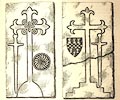 click to enlarge
click to enlargeG850E01.jpg
"No accompaniment to the cross is more common than a sword, as might be presumed from the military character of feudal times. Mr. Boutell has placed side by side the very similar stones at Brougham, in Westmorland, and at Newton Rigney, in Cumberland, the former ascribed to Udard de Broham, who, having taken the cross in the second crusade, died about the year 1185; and the latter bearing the arms of Vaux of Catterlen, whose name has been associated in the title of peerage conferred on the ex-chancellor. The circular figure on the Brougham stone is supposed to represent a target-shield. ..."
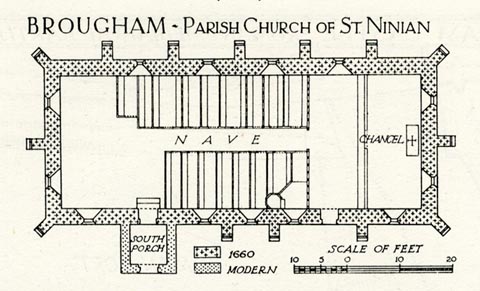 click to enlarge
click to enlargeHMW040.jpg
On p.56 of the Inventory of the Historical Monuments in Westmorland.
printed, top "BROUGHAM - PARISH CHURCH OF ST NINIAN"
RCHME no. Wmd, Brougham 2
item:- Armitt Library : A745.40
Image © see bottom of page
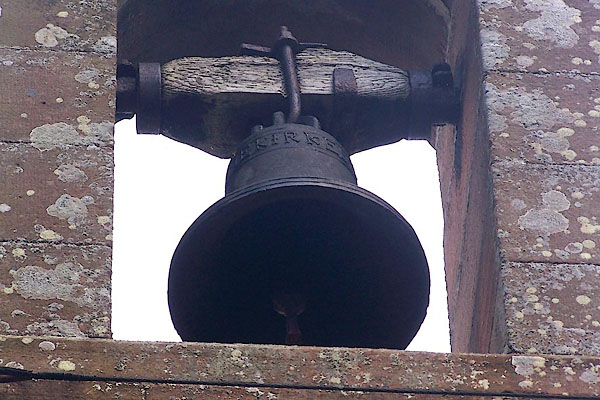
BMT40.jpg Bell, inscription:-
"Ninekirkes Ano 1696 R.A." (taken 6.10.2006)
 memorials and coats of arms
memorials and coats of arms stained glass
stained glass hatchments
hatchmentsplacename:- Church of St Ninian
courtesy of English Heritage
"CHURCH OF ST NINIAN / / NINEKIRKS / BROUGHAM / EDEN / CUMBRIA / I / 74217 / NY5593629961"
courtesy of English Heritage
"Redundant parish church. 1660, on medieval site, for Lady Anne Clifford, porch dated 1841. Red sandstone rubble walls with regularly-spaced buttresses, porch of reeded red sandstone ashlar; graduated greenslate roof with C19 west bellcote. 4-bay nave with single-bay chancel, under common roof. Porch has Tudor-arched doorway with date panel above. Nave and chancel have small round-arched windows in hollow double-chamfered surrounds under hoodmoulds. Chancel has south round-arched priest's doorway under hoodmould. Windows in east and west walls are similar but slightly taller than those in north and south walls. Porch covers flattened segmental-headed C17 doorway. Interior has much of its original 1660s woodwork; 9-bay roof with collar-beam trusses having curved braces and short kingposts above the collar beams. Original box pews, some on north side to their original height (with restoration) having turned balusters. Chancel screen with turned balusters, but central doors missing. 7-sided pulpit with sounding board. Pedestal font on C20 base is dated 1662. 3 hatchments of arms. Poor box beside door is inscribed and dated 1663. Chancel has plaster wreath enclosing initials AP (Anne Pembroke) 1660. Priest's door screen is made up of carved C17 panels. C17 heavy turned-baluster altar rail. Creed and Pater boards on east wall. Various C18 and C19 wall plaques to the Brougham family, one set into floor. Reset floor slab to Cuthbert Bradley, incumbent, 1624. 3 further slate slabs with brass figures and coats-of-arms are C19, recording earlier members of the Brougham family. Church now maintained by the Redundant Churches Fund. See RCHM, Westmorland, 1936, pp.54-6."
 cross slabs
cross slabs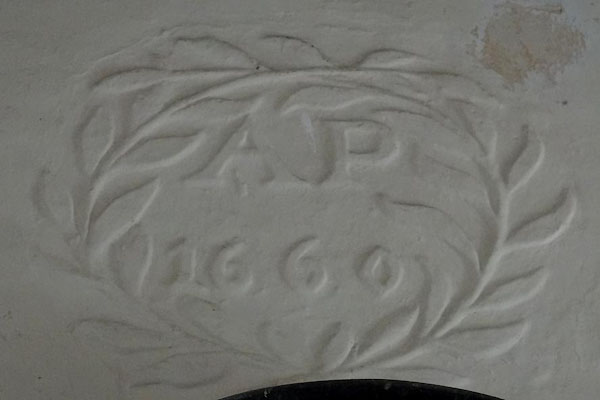
CBW94.jpg The church was rebuilt by Lady Anne Clifford (Anne Pembroke), 1660; east wall:-
"AP 1660" (taken 24.10.2014)
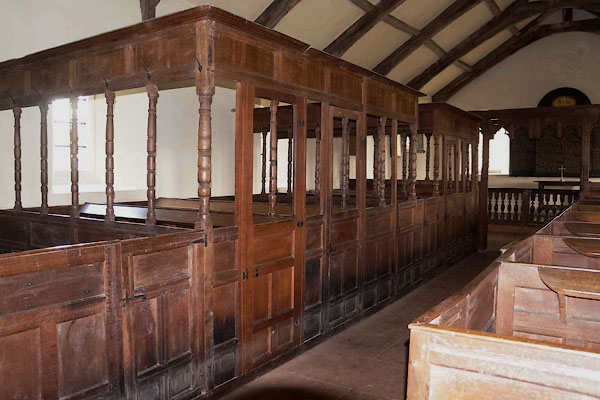
CBW93.jpg Pews, dated 1661.
(taken 24.10.2014)

CBX19.jpg Pew, catch..
(taken 24.10.2014)
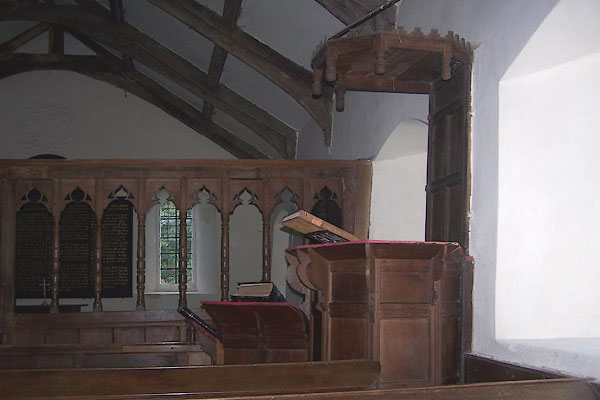
BMT39.jpg Pulpit and screen.
(taken 6.10.2006)
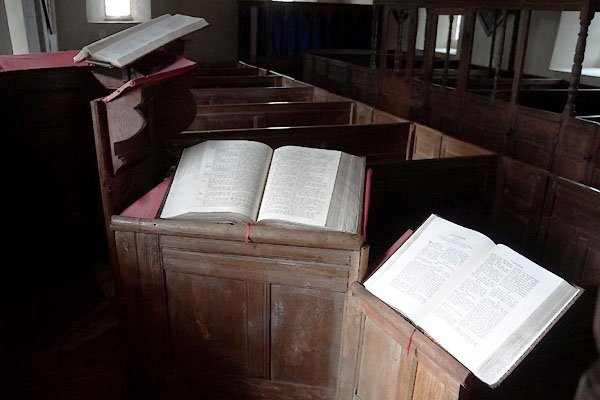
CBX16.jpg Pulpit, with three reading desks.
(taken 24.10.2014)
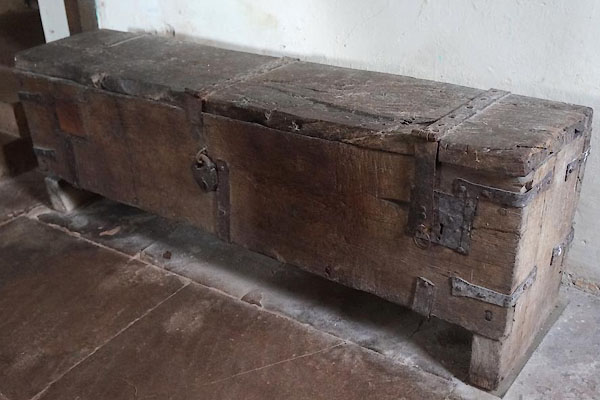
CBX20.jpg Parish chest.
(taken 24.10.2014)
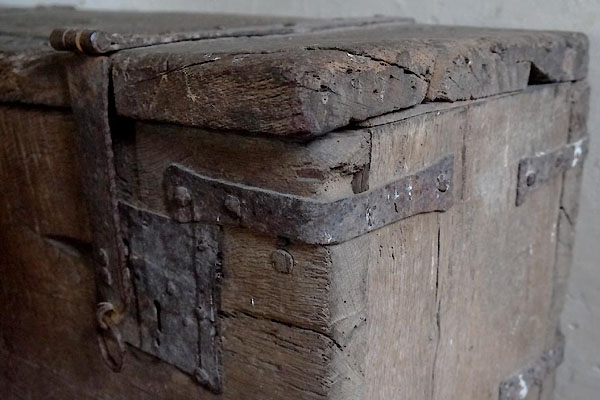
CBX21.jpg Parish chest.
(taken 24.10.2014)
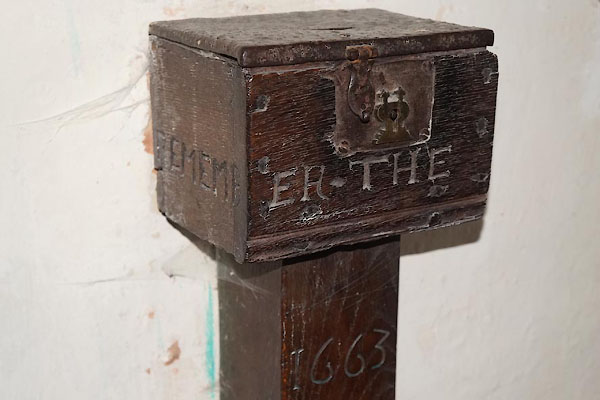
CBX18.jpg Poor box:-
"REMEMB / ER THE / [POOR]" (taken 24.10.2014)
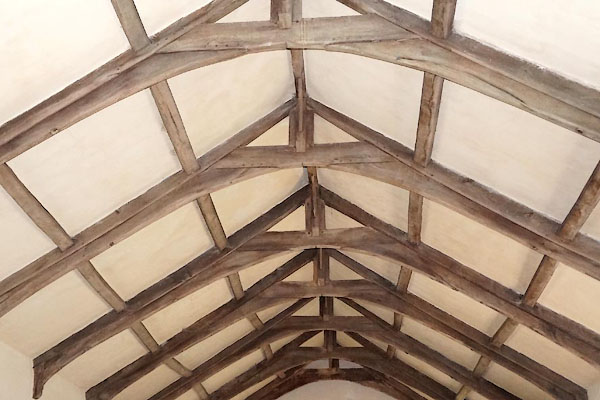
CBW88.jpg Roof beams.
(taken 24.10.2014)
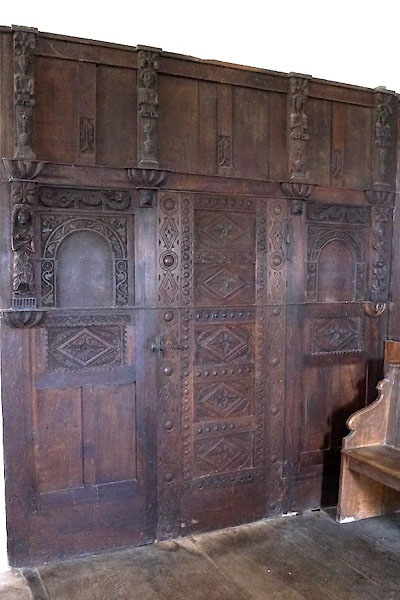
CBX14.jpg Panelling by door.
(taken 24.10.2014)
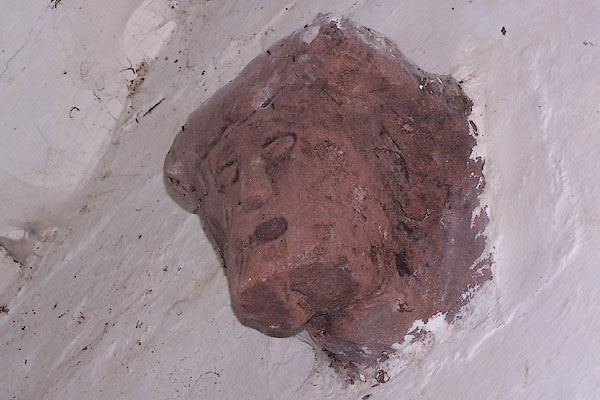
BMT41.jpg Medieval corbel, reset in the porch.
(taken 6.10.2006)
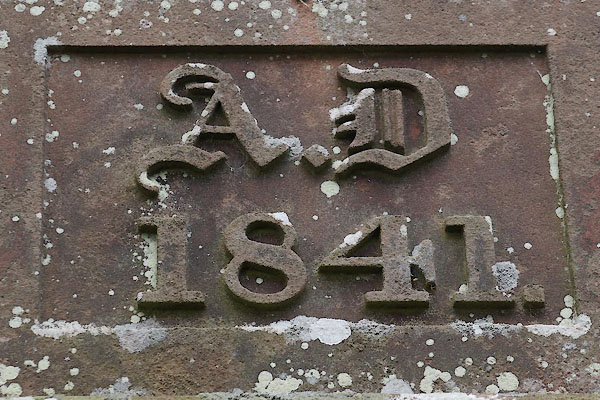
CBW86.jpg Date on porch:-
"A.D / 1841" (taken 24.10.2014)
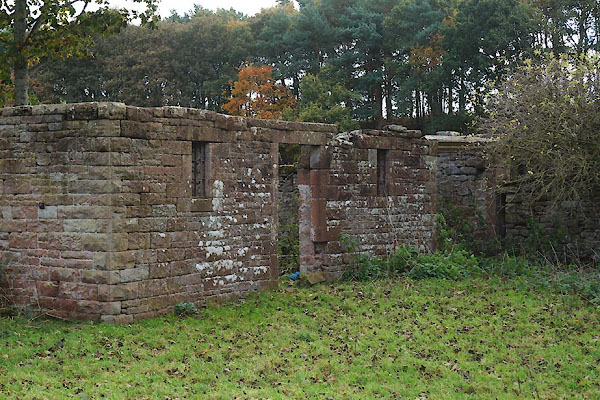
CBX24.jpg 18th century stable for the parson's pony and cart.
(taken 24.10.2014)
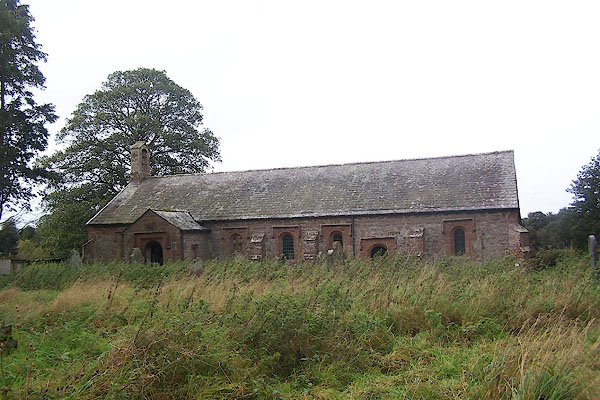
BMT30.jpg (taken 6.10.2006)
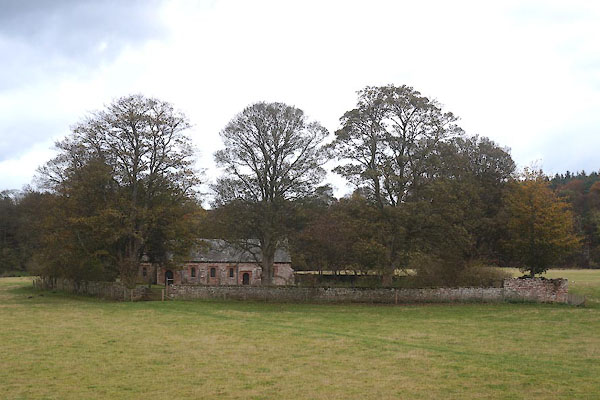
CBW83.jpg (taken 24.10.2014)
